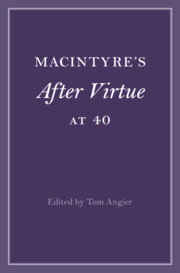Book contents
- MacIntyre’s After Virtue at 40
- Cambridge Philosophical Anniversaries
- MacIntyre’s After Virtue at 40
- Copyright page
- Contents
- Contributors
- Introduction
- Part I After Virtue and Ethical Theory
- Part II After Virtue and Political Theory
- Part III After Virtue and Narrative
- 8 Form, Style and Voice in After Virtue
- 9 After Virtue, Narrative and the Human Good
- 10 After Virtue as a Narrative of Revolutionary Practical Reason
- Part IV After Virtue beyond Philosophy
- Bibliography
- Index
8 - Form, Style and Voice in After Virtue
from Part III - After Virtue and Narrative
Published online by Cambridge University Press: 12 October 2023
- MacIntyre’s After Virtue at 40
- Cambridge Philosophical Anniversaries
- MacIntyre’s After Virtue at 40
- Copyright page
- Contents
- Contributors
- Introduction
- Part I After Virtue and Ethical Theory
- Part II After Virtue and Political Theory
- Part III After Virtue and Narrative
- 8 Form, Style and Voice in After Virtue
- 9 After Virtue, Narrative and the Human Good
- 10 After Virtue as a Narrative of Revolutionary Practical Reason
- Part IV After Virtue beyond Philosophy
- Bibliography
- Index
Summary
In this chapter, I plan to explore the significance of the form of After Virtue – to examine its distinctive, even idiosyncratic, strategies for expressing and articulating its views, to consider their relation to various aspects of the argument that MacIntyre is attempting to make and to suggest that if we take those formal idiosyncrasies more seriously than is currently the case in the secondary literature we may cast new light on the nature and significance of MacIntyre’s project. Formal matters of particular importance here are the essentially narrative cast of the book, its opening with a disquieting suggestion that is advanced via a peculiar thought experiment, its emphasis on the idea of ‘characters’ as crystallising the evaluative horizons of a form of life and its recurrent preoccupation with authors whose own philosophical and ethical work is analogously shaped (e.g. Austen, Kierkegaard and Nietzsche). I compare and contrast these features of After Virtue with their textual successors: the forms of Whose Justice? Which Rationality? and Rational Dependent Animals being obviously pertinent examples.
- Type
- Chapter
- Information
- MacIntyre's After Virtue at 40 , pp. 143 - 158Publisher: Cambridge University PressPrint publication year: 2023



